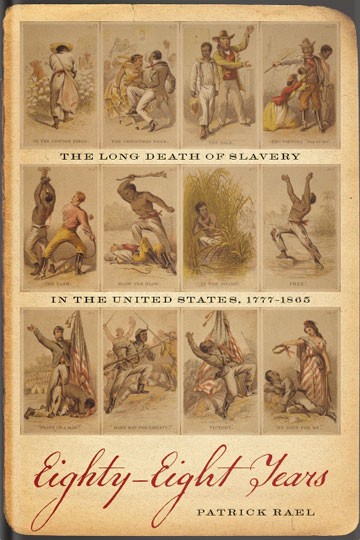
- Publisher: Athens: University of Georgia Press
- Available in: Hardcover, Paper, Ebook
- Published: August 1, 2015
Finalist for the Harriet Tubman Prize, awarded by the New York Library’s Lapidus Center for the Historical Analysis of Transatlantic Slavery, at the Schomburg Center for Research in Black Culture.
Why did it take so long to end slavery in the United States, and what did it mean that the nation existed eighty-eight years as a “house divided against itself,” as Abraham Lincoln put it? The decline of slavery throughout the Atlantic world was a protracted affair, says Patrick Rael, but no other nation endured anything like the United States. Here the process took from 1777, when Vermont wrote slavery out of its state constitution, to 1865, when the Thirteenth Amendment abolished slavery nationwide.
Rael immerses readers in the mix of social, geographic, economic, and political factors that shaped this unique American experience. He not only takes a far longer view of slavery’s demise than do those who date it to the rise of abolitionism in 1831, he also places it in a broader Atlantic context. We see how slavery ended variously by consent or force across time and place and how views on slavery evolved differently between the centers of European power and their colonial peripheries—some of which would become power centers themselves.
Rael shows how African Americans played the central role in ending slavery in the United States. Fueled by new Revolutionary ideals of self-rule and universal equality—and on their own or alongside abolitionists—both slaves and free blacks slowly turned American opinion against the slave interests in the South. Secession followed, and then began the national bloodbath that would demand slavery’s complete destruction.
Reviews
This comprehensive history of slavery in the United States is expertly researched and brilliantly presented. History, in hindsight, can look like a series of events that were more or less inevitable. Patrick Rael, however, doesn’t take the easy way out in this staggeringly impressive tome: He is careful to portray the complexity surrounding each step of the abolition movement and its eventual success. History buffs should run, not walk, to purchase Eighty-Eight Years. That said, it seems that this book also has enormous potential to reach a broader audience, too.
– (Bookish.com)
A very smart book. . . . Rael achieves something remarkable. . . . A must-read for those interested in the history of abolition in the United States.
– (Sebastian Jobs, H-Net)
Patrick Rael’s elegant prose wisely tells this narrative from a number of perspectives. Like all smart social historians, Rael understands that power cannot be ignored, and politicians on both sides of the Civil War are given voice in this important work.
– (Douglas R. Egerton author of Year of Meteors: Stephen Douglas, Abraham Lincoln, and the Election that Brought on the Civil War)
Rael examines the long, slow death of slavery in the United States, masterfully showing how each event is connected and letting us in on secrets that textbooks never mentioned. . . . Rael enlightens us on the wide differences in slavery throughout the New World and its ending through the Caribbean and Latin America, and he effectively shows the difficulties of emancipation, reconstruction, and the pervading white supremacy of the North. There are not enough superlatives to describe the wealth of information in this book and the bright, clear way in which it is taught. Just buy it.
– (Kirkus Reviews (starred review))
In this meticulously researched study . . . Rael adds detail and nuance to a story with which readers might have believed themselves already well acquainted.
– (Publishers Weekly)
This important and vigorously argued study of the process of emancipation in the US, a process that began with Vermont’s abolition of slavery in 1777 and culminated with the Thirteenth Amendment in 1865?eighty-eight years?examines American abolition and emancipation over time, broadening the perspective on a story that usually begins with the rise of radical abolitionists in the early 1830s. With its wider chronological lens and hemispheric context, Rael’s book is a must-read study of slavery and its end in the US.
– (K.M. Gannon, Choice)
While many historians have built upon the work of Leonard Richards in describing the slave power’s domination of US politics in the antebellum era, none have explained it as thoroughly as Patrick Rael has in his synthetic, yet path-breaking, work on antislavery in the Atlantic. . . . His goal is to explain why it took eighty-eight years and a civil war to end slavery in the United States, and he achieves this through tight, yet thorough, analysis and the elegant, yet clear, prose his works are known for.
– (Beverly Tomek, American Book Review)
Other historians have increasingly made connections between slavery in the Atlantic and the United States, though Rael does much more than make connections – he succeeds at showing the strong similarities between Atlantic slaveholding societies, while at the same time explaining why this United States retained a strong interest in slavery longer than almost anywhere else.
– (James J. Gigantino II, Arkansas Historical Quarterly)
[A]n impressive achievement. . . . An ambitious synthetic work such as this is inevitably open to various qualms, protests, and quibbles. Among this work’s multiple strengths is that it invites and rewards such critical engagement.
– (Matthew Mason, Journal of American History)